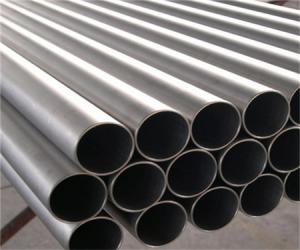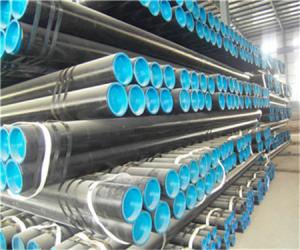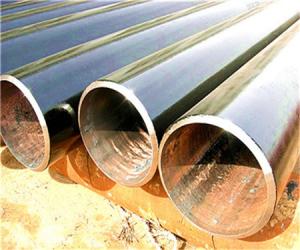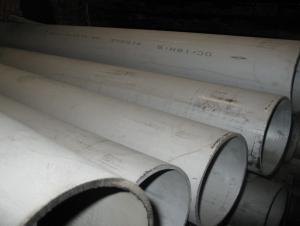Welded 304 Stainless Steel Pipes Manufacturer
- Loading Port:
- China Main Port
- Payment Terms:
- TT or LC
- Min Order Qty:
- 30 kg
- Supply Capability:
- 12000 kg/month
OKorder Service Pledge
OKorder Financial Service
You Might Also Like
Specifications
1、Structure of Seamless Pipe ASTM A106/53 Description:
Seamless pipe is formed by drawing a solid billet over a piercing rod to create the hollow shell. As the manufacturing process does not include any welding, seamless pipes are perceived to be stronger and more reliable. Historically seamless pipe was regarded as withstanding pressure better than other types, and was often more easily available than welded pipe.
2、Main Features of the Seamless Pipe ASTM A106/53:
• High manufacturing accuracy
• High strength
• Small inertia resistance
• Strong heat dissipation ability
• Good visual effect
• Reasonable price
3、Seamless Pipe ASTM A106/53 Specification:
Standard | GB, DIN, ASTM ASTM A106-2006, ASTM A53-2007 |
Grade | 10#-45#, 16Mn 10#, 20#, 45#, 16Mn |
Thickness | 8 - 33 mm |
Section Shape | Round |
Outer Diameter | 133 - 219 mm |
Place of Origin | Shandong, China (Mainland) |
Secondary Or Not | Non-secondary |
Application | Hydraulic Pipe |
Technique | Cold Drawn |
Certification | API |
Surface Treatment | factory state or painted black |
Special Pipe | API Pipe |
Alloy Or Not | Non-alloy |
Length | 5-12M |
Outer Diameter | 21.3-610mm |
Grade | 20#, 45#, Q345, API J55, API K55, API L80, API N80, API P110, A53B |
Standard | ASME, ASTM |
1) Material:20#(ASTM A 106/A53 GRB.API5LGRB,GB),45#,16Mn,10#.
2) Specification range:OD:21.3-610mm,WT:6-70mm,length:6-12m or according to the requirement of clients.
3) Excutive standards:GB,ASME API5L.ASTM A 106/A53,Despite of the above standards,we can also supply seamless steel pipe with standard of DIN,JIS,and so on,and also develop new products according to the requirements of our clients!
4) Surface:black lacquered,varnish coating or galvanized.
5) Ends:Beveled or square cut,plastic capped,painted.
6) Packing:bundles wrapped with strong steel strip,seaworthy packing.
4、Packaging & Delivery
Packaging Details: | seaworthy package,bundles wrapped with strong steel strip |
Delivery Detail: | 15-30days after received 30%TT |
5、FAQ of Seamless Pipe ASTM A106/53:
①How is the quality of your products?
Our products are manufactured strictly according to national and internaional standard, and we take a test
on every pipe before delivered out. If you want see our quality certifications and all kinds of testing report, please just ask us for it.
Guaranteed: If products’ quality don’t accord to discription as we give or the promise before you place order, we promise 100% refund.
②How about price?
Yes, we are factory and be able to give you lowest price below market one, and we have a policy that “ for saving time and absolutely honest business attitude, we quote as lowest as possible for any customer, and discount can be given according to quantity”,if you like bargain and factory price is not low enough as you think, just don’t waste your time.Please trust the quotation we would give you, it is professional one.
③Why should you chose us?
Chose happens because of quality, then price, We can give you both.Additionally, we can also offer professional products inquiry, products knowledge train(for agents), smooth goods delivery, exellent customer solution proposals.Our service formula: good quality+good price+good service=customer’s trust
SGS test is available, customer inspection before shipping is welcome, third party inspection is no problem.
6、Seamless Pipe ASTM A106/53 Images:

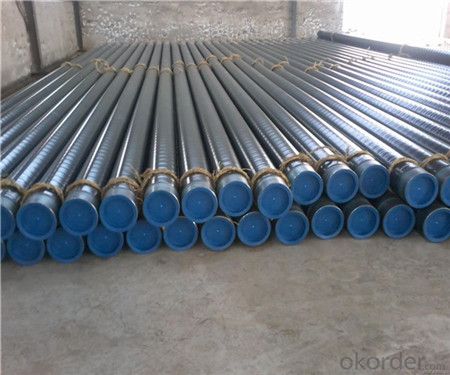
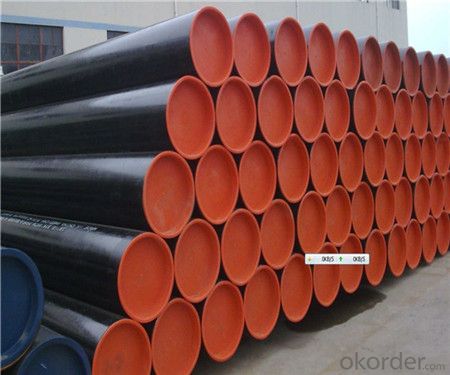
- Q:Can stainless steel pipes be used for nuclear power plants?
- Stainless steel pipes are indeed suitable for nuclear power plants. The utilization of stainless steel is widespread in the fabrication of nuclear power plants owing to its exceptional resistance against corrosion and its strength in high-temperature conditions. These characteristics are crucial for enduring the challenging operational circumstances typically encountered within nuclear power plants, including elevated temperatures and corrosive surroundings. Moreover, stainless steel is renowned for its durability and prolonged lifespan, rendering it a dependable option for pivotal purposes in the nuclear sector.
- Q:How do you measure the thickness of a stainless steel pipe?
- There are various techniques available for measuring the thickness of a stainless steel pipe, depending on the tools at hand and the desired level of accuracy. One commonly used approach involves utilizing a caliper or micrometer, which are precision measuring instruments. By opening the caliper and positioning one jaw on the outside surface of the pipe and the other jaw on the inside surface, one can determine the distance between the jaws. This measurement provides the thickness of the pipe. Another option involves utilizing an ultrasonic thickness gauge. This device emits high-frequency sound waves that penetrate the pipe and bounce back from the inner wall. By measuring the time it takes for the sound waves to travel and return, the gauge can calculate the pipe's thickness. For larger pipes or situations requiring greater precision, a laser-based method can be employed. Laser-based devices use a laser beam to scan the pipe's surface and measure the distance from the beam to the surface. By scanning along the pipe's circumference, multiple measurements can be obtained and averaged to establish the thickness. It is important to note that prior to measuring the thickness, it is crucial to ensure that the pipe's surface is clean and devoid of any debris or coatings that might impact the accuracy of the measurements. Additionally, it is advisable to take multiple measurements at different points along the pipe's length to account for any variations in thickness.
- Q:How do stainless steel pipes compare to polyvinyl chloride pipes?
- Stainless steel pipes have a higher durability and can withstand higher pressures and temperatures compared to polyvinyl chloride (PVC) pipes. Additionally, stainless steel pipes are resistant to corrosion, making them suitable for a wide range of applications, including in harsh environments. On the other hand, PVC pipes are lightweight, easy to install, and more affordable. However, they are not as durable as stainless steel and have limitations in terms of pressure and temperature resistance. Ultimately, the choice between stainless steel and PVC pipes depends on the specific requirements and conditions of the project.
- Q:Are stainless steel pipes suitable for hot water applications?
- Indeed, stainless steel pipes are well-suited for the purpose of hot water applications. Renowned for its remarkable resistance to corrosion, stainless steel proves to be the perfect candidate for incorporation in plumbing systems that involve the use of hot water. The ability of stainless steel to withstand high temperatures guarantees that it can endure the heat generated by hot water without suffering any deterioration or harm. Furthermore, the internal surface of stainless steel pipes possesses a sleek texture, thereby aiding in the preservation of the integrity and purity of the hot water during transportation. Ultimately, stainless steel pipes emerge as a dependable and long-lasting option for utilization in hot water applications.
- Q:Are stainless steel pipes resistant to chloride stress corrosion cracking?
- Yes, stainless steel pipes are generally resistant to chloride stress corrosion cracking. Stainless steel is known for its high resistance to corrosion, including in chloride environments. The presence of chromium in stainless steel forms a passive layer on the surface that protects it from corrosion. This passive layer prevents the penetration of chloride ions and minimizes the risk of stress corrosion cracking. However, the resistance to chloride stress corrosion cracking can vary depending on the specific grade of stainless steel and the environment it is exposed to. It is important to choose the appropriate grade of stainless steel with adequate resistance to chloride stress corrosion cracking for specific applications, especially in high chloride environments such as coastal areas or industrial settings.
- Q:Can stainless steel pipes be used for pharmaceutical industries?
- Yes, stainless steel pipes can be used for pharmaceutical industries. Stainless steel is a preferred material choice in pharmaceutical applications due to its high corrosion resistance, durability, and hygienic properties. It is commonly used for transporting pharmaceutical liquids, gases, and chemicals in a safe and sterile manner, making it suitable for pharmaceutical manufacturing and processing operations.
- Q:Can stainless steel pipes be used in underground installations?
- Yes, stainless steel pipes can be used in underground installations. Stainless steel is known for its corrosion resistance, which makes it a suitable material for underground applications where pipes are exposed to moisture and other corrosive elements. Stainless steel pipes are durable, long-lasting, and can withstand high pressure and extreme temperatures. Additionally, stainless steel is also resistant to damage from underground soil movements. Therefore, it is a reliable choice for underground installations such as water and gas supply systems, sewage systems, and industrial pipelines.
- Q:Can stainless steel pipes be used for solar energy systems?
- Yes, stainless steel pipes can be used for solar energy systems. Stainless steel is a versatile and durable material that can withstand the harsh conditions of solar energy systems. It is resistant to corrosion, which is crucial for the longevity of the pipes in outdoor and exposed environments. Stainless steel pipes also have excellent heat resistance properties, making them suitable for transporting hot fluids within solar energy systems. Additionally, stainless steel has a high strength-to-weight ratio, making it ideal for supporting the weight of solar panels or other components in the system. Overall, stainless steel pipes are a reliable and efficient choice for solar energy systems.
- Q:How are stainless steel pipes measured?
- Two main parameters are used to measure stainless steel pipes: outer diameter (OD) and wall thickness. The outer diameter corresponds to the pipe's outer circumference, while the wall thickness indicates the thickness of the pipe's walls. These measurements are crucial for determining the pipe's suitability for a particular application and ensuring compatibility with fittings and connectors. Stainless steel pipe dimensions are typically stated in millimeters or inches, and they may vary depending on project requirements or industry standards. Precise measurement is essential to guarantee the correct fitting and functionality of stainless steel pipes in diverse applications, including plumbing, construction, or industrial processes.
- Q:Can stainless steel pipes be insulated with cellulose?
- Yes, stainless steel pipes can be insulated with cellulose. Cellulose insulation is a common choice for insulating pipes due to its high thermal resistance and fire-resistant properties. It can be used on various types of pipes, including stainless steel. Cellulose insulation can be applied to the pipes using different methods, such as wrapping the pipes with cellulose insulation blankets or filling the pipe cavities with loose-fill cellulose insulation. Insulating stainless steel pipes with cellulose can help prevent heat loss, reduce energy consumption, and ensure the pipes maintain a consistent temperature.
1. Manufacturer Overview |
|
|---|---|
| Location | |
| Year Established | |
| Annual Output Value | |
| Main Markets | |
| Company Certifications | |
2. Manufacturer Certificates |
|
|---|---|
| a) Certification Name | |
| Range | |
| Reference | |
| Validity Period | |
3. Manufacturer Capability |
|
|---|---|
| a)Trade Capacity | |
| Nearest Port | |
| Export Percentage | |
| No.of Employees in Trade Department | |
| Language Spoken: | |
| b)Factory Information | |
| Factory Size: | |
| No. of Production Lines | |
| Contract Manufacturing | |
| Product Price Range | |
Send your message to us
Welded 304 Stainless Steel Pipes Manufacturer
- Loading Port:
- China Main Port
- Payment Terms:
- TT or LC
- Min Order Qty:
- 30 kg
- Supply Capability:
- 12000 kg/month
OKorder Service Pledge
OKorder Financial Service
Similar products
New products
Hot products
Hot Searches
Related keywords
